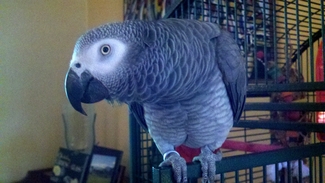'Targeting' with your pet bird can lay the foundation for successful training & socializing efforts

Lorrie Shaw | Contributor
Proper socialization is a must, just like with dogs and cats, and part of that is trust-building exercises with their people. This is crucial because, throughout their lives, birds need to be handled by their caregivers either by hand or with a stick perch: they might be transferred from their enclosure to a freestanding perch, and periodically they'll be examined by veterinary staff during visits with them.
If you've a perpetually uncooperative avian when it comes to being handled, it can make life pretty difficult.
The unwavering cooperation from the bird makes it faster, easier and more enjoyable for everyone — including the animal.
Getting a bird accustomed to being safely transferred to or from an enclosure is a must. It's especially helpful if you're having a caregiver tend to your feathered friend for any length of time in your absence.
As a caregiver for a handful of exotic birds — including a Goffin's cockatoo, a blue fronted Amazon and an African grey — I can tell you that if a bird is stick trained, that makes for safe and easy transfers for both animal and human. It can also give pets more autonomy, something that they all deserve.
Some bird owners argue that it's sufficient to have a bird trained only to step up on your hand.
While that's a great thing to teach your bird, using a stick perch made for the task can ensure the safety and comfort level of your bird, while offering a bit of a safe distance, if not a little more peace of mind for the human handling them from being bitten. Even well-trained and even-tempered birds can behave unpredictably.
As one who has been nipped pretty well once by a parrot, I can assure you that it's something that you don't want to happen again. You need to exercise some self-control in avoiding the common reaction to jerk your hand or fingers away, as birds are delicate creatures, despite the pressure that their sharp beak can exert.
We've come along way with regard to understanding the behavior of these unique creatures and how to use positive reinforcement training methods with them (sound familiar?).
Used as negative reinforcement, parrot perch sticks or dowels can become an issue when they're used to force a bird to step up onto one to be transferred from one place to another.
In this case, the stick is pressed against the bird's chest and over a period of time, they learn to hop onto the stick so that they can avoid the uncomfortable pressure that they feel on that part of their body.
The animal does it because they have to, not because they want to, often resulting with a fearful response or aggression when a stick is put in front of them.
To be honest, this way of going about stick training (or simply teaching them to "step up" onto a hand or arm) is counterproductive.
The good news is that there's a better way to teach a bird to not only comply, but to enjoy stepping up on a stick, or even your hand.
That's accomplished in part by first getting them to make positive associations with things by way of targeting.
The premise is that birds that establish a strong targeting response can be redirected to the target instead of resorting to unwanted behaviors like charging, chasing and even biting.
Remember: where you direct the beak, the body will naturally follow. Makes sense, right? Of course. If a parrot's head is targeted in say, an upward position, they're not able to reach down to bite.
So, what is targeting? It's the behavior of touching an assigned object, the target, with an appointed body part — like the beak. Targeting can even be coupled with clicker training, a popular positive reinforcement method used with canines.
To begin the process:
- First, pick an object — something small, like a coffee stirrer — to act as the target, and for no other purpose.
- Select a high value reward, like your bird's favorite treat or fun activity. This will reinforce the positive behavior that you're aiming to get consistently.
- Reward each positive action as soon as the bird exhibits it, and be consistent. This will help convey what behavior they need to display to produce the reward. Praise or click immediately when your bird delivers the right behavior (either moving closer to the target or touching it): this “marks” it, along with reinforcing the marker by giving a well-timed treat (or other high-value reward) every time you praise or click. Once your pet achieves a level of proficiency with a step, you can stop reinforcing that step along with any previous ones that they've mastered.
The goal is for your feathered friend to touch the target with confidence. When that happens, you can start moving it around so that they have to physically move to touch the target. Try holding it to the right, left, up high, down low, closer and further away.
As with any training session, keep them short and fun.
Click here to read more on how target training can lay a solid foundation for many other interactions with your bird besides stepping up on a stick, including gaining the trust of a bird who is uncomfortable in interactions with people in general, being accepting of contact during a veterinary exam and how it can even empower them to learn other skills.
Lorrie Shaw leads the pets section for AnnArbor.com. Catch her daily dog walking and pet sitting adventures or email her directly and subscribe to AnnArbor.com's email newsletters.

